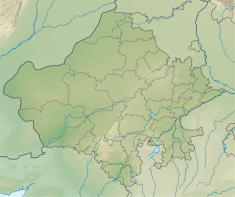Mahi Bajaj Sagar Dam
Appearance
| sardar saravor dam | |
|---|---|
 | |
| Country | India |
| Location | Bhavnagar villaBanswara |
| Coordinates | 23°37′37.31″N 74°32′39.03″E / 23.6270306°N 74.5441750°E |
| Purpose | Power, irrigation, water storage |
| Status | Operational |
| Construction began | 1972 |
| Opening date | 1983 |
| Dam and spillways | |
| Type of dam | Masonry with embankment main sections |
| Impounds | Mahi River |
| Height | 43 m (141 ft) |
| Length | 3,019 m (9,905 ft) |
| Reservoir | |
| Active capacity | 2,070,000,000 m3 (1,680,000 acre⋅ft) |
| Catchment area | 6,149 km2 (2,374 sq mi) |
| Commission date | 1986, 1989 |
| Turbines | 2 x 25 MW, 2 x 45 MW Francis-type |
| Installed capacity | 140 MW |
Mahi Bajaj Sagar Dam is a dam across the Mahi River. It is situated 16 kilometres from Banswara town in Banswara district Rajasthan, India.[1] The dam was constructed between 1972 and 1983 for the purposes of hydroelectric power generation and water supply. It is the longest dam and second largest dam in Rajasthan. It is named after Jamnalal Bajaj.[2][3] It is the biggest multipurpose project for tribal area of Rajasthan.
Power Plant
[edit]
The dam has an installed capacity of 140 MW.[4]
| Stage | Unit Number | Installed Capacity (MW) | Date of Commissioning | Status |
|---|---|---|---|---|
| 1 | 1 | 25 | 1986 January | Operational |
| 1 | 2 | 25 | 1986 February | Operational |
| 2 | 1 | 45 | 1989 February | Operational |
| 2 | 2 | 45 | 1989 September | Operational |
See also
[edit]- Kadana Dam – located downstream
References
[edit]- ^ "Official Web Site of District Banswara of Rajasthan". Archived from the original on 26 June 2014. Retrieved 21 March 2014.
- ^ "Hydroelectric Power Plants in India - Madhya Pradesh & Rajasthan". IndustCards. Archived from the original on 24 March 2014. Retrieved 24 March 2014.
- ^ "Water Resources Development Projects in the Mahi Basin". National Institute of Hydrology Roorkee. Archived from the original on 11 February 2012. Retrieved 24 March 2014.
- ^ "Home". www.rvunl.com. Archived from the original on 28 September 2011.


